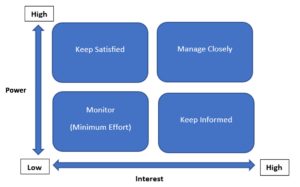by Business Analysis,
According to IIBA a stakeholder is defined as a group or individual with a relationship to the change, the need, or the solution. All stakeholders will not have same amount of involvement to a project as their level of interest to a given project and their power within the organization varies. Hence, it is important to identify the expectations of the stakeholders, identify the expectations a BA needs to set for stakeholders and the strategies to manage the expectations to minimize the negative impact from stakeholders. However, this becomes even harder when we need to manage a very large group of stakeholders during a project lifecycle. They can represent the same organisation (or multiple organisations) yet, every stakeholder will have their own interests, expectations, and preferences. Therefore, it can be challenging to develop and maintain positive relationships with all stakeholders and manage their expectations to eliminate project delays, mitigate risks, and meet project goals.
Identify your stakeholders

It is vital that you identify all stakeholders at the beginning of the project. We need to be aware that some stakeholders won’t come into play until later in the project lifecycle. But as a BA if you can identify them at an early stage then it will be
easy to build the relationship from the outset and help them to feel involved from the beginning. Do not limit stakeholder identification to their name, their job title, and their organisation/department. It is important to identify their proximity to the project, level of interest, their needs, and expectations from the project. A stakeholder register can be used to formally record your findings.
Prioritise your stakeholders
Group the stakeholders based on their power / ability to influence vs. their interest. Each group will have different interests, goals, objectives, and plans. Hence, this grouping will help the BA to identify the key stakeholders from a large group of stakeholders and identify the strategies to work closely with them to keep the project moving forward without getting pulled in every direction creating lot of stress.
High Power – High Interest
It is critical to fully engage these stakeholders and put extra effort to keep them satisfied at all times. Pay attention to their inputs and decisions all the time.
High Power – Low Interest
Although they are powerful, they have little involvement to the project. Do your best to keep these stakeholders satisfied with relevant information without taking much of their time . Deal with these stakeholders cautiously as they have power to negatively impact the project if they become unsatisfied.
Low Power – High Interest
Work we do as a BA may directly impact these stakeholders. For example, if you are gathering requirements for Sales and Marketing solution, these are the stakeholders who are going to use this solution on a day-to-day basis for business operations upon implementation. Usually, they are willing to help us out, but some may show their resistance if they believe that the new implementation negatively impacts their job. Keep them informed and win their trust and support to make the project a success.
Low Power – Low Interest
These stakeholders are the least affected and less powerful. Monitor them periodically but do not spend excessive amount of time for communication.
Understand your stakeholders
Once you are aware about the key players and their priority, it is essential to understand their expectations, their concerns about the project, their definition of project success, how project outcome would impact their work (positive or negative), and whether there are any conflicts of interest among the stakeholders that you need to be aware of. Such understanding will help the BA to understand every key stakeholder in detail and draw a bigger picture of the stakeholder network. Also, we need to keep our eyes open for any political or cultural cues as it will provide an essential context on how to manage the stakeholders and their expectations.

Dealing with “challenging” stakeholders
You may not find all “challenging” stakeholders at the beginning of the project. The nature of the stakeholder can be changed from “supportive” to “opposing” at any stage of the project life cycle. We may need to take actions as soon as we see the red flags before it’s too late. We cannot dismiss challenging stakeholders, but we should be able to find ways to work with them and defuse the tension. As a BA we need to see where challenging stakeholders are coming from and understand their motivation. Do not close communication channels with these stakeholders simply because you don’t want to deal with them. Instead give them opportunities to share their insights and opinions and try to find the common grounds. A one-on-one meeting may take the pressure off and make both parties more comfortable to have a clear and calm conversation.
Follow best practices
Always follow the best practices to develop and maintain stakeholder relationships. Use the stakeholder registry to prepare a stakeholder engagement plan which includes stakeholder roles and responsibilities, communication requirements including timeframes and frequency, level of information to be distributed among stakeholders, escalation process, etc. Share the stakeholder engagement plan with all stakeholders to ensure that all stakeholders are aware about their roles and responsibilities and the appropriate engagement strategies used to engage with the stakeholders throughout the project life cycle. It allows you to keep the right people informed at the right times. Keep your stakeholders informed and included throughout the lifecycle. Make sure to share the meeting minutes with relevant parties, even if they were unable to make it to the meeting due to other work commitments. Always provide visibility to stakeholders by sharing project status reports and updated work plan with them.
Bottom line…
Remember that change is the only constant in a project lifecycle. Stakeholder priorities may change as their power and interest changes. Observe changes and act accordingly. A supportive stakeholder might become a roadblock overnight. Manage them and monitor them closely. Keep all your communication channels open to wipe out any growing negativity. Do not limit stakeholder management to the planning stage of project lifecycle, it must be continued throughout the project lifecycle.
